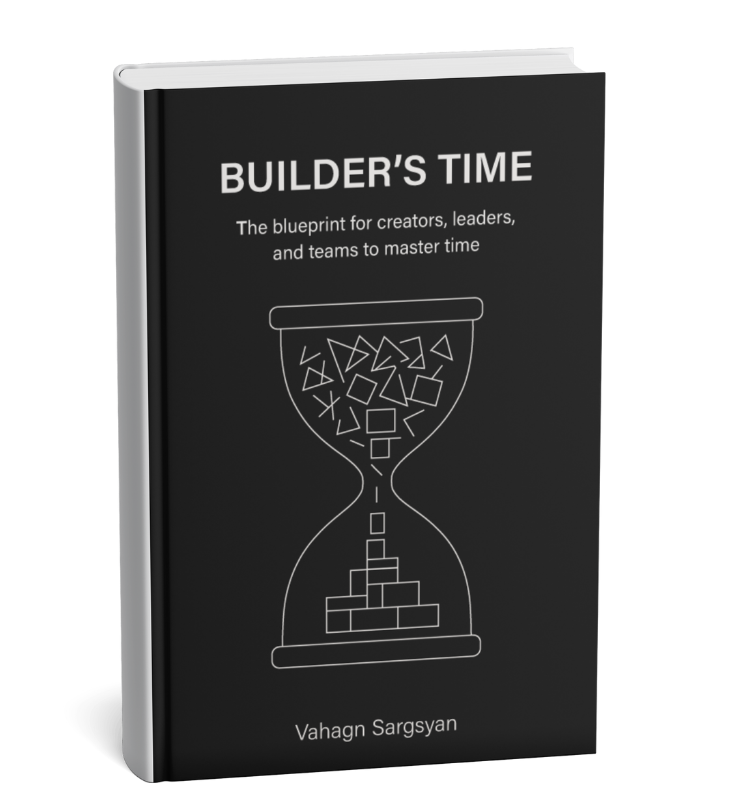Personal Time:
Have you thought about why you produced only 2-3 hours of real value when, in fact, you'd been working for 10 hours? It's all because of energy rhythms, focus patterns, and the invisible transitions that eat 70% of your day.
Leading the team behind WebWork Time Tracker and various tech ventures. Based in San Francisco, I collaborate with talented individuals worldwide.
To manage your time effectively, you need to design it effectively first.
Every builder starts with the same resource: time. Not capital. Not headcount. The difference between drift and momentum is how your hours flow through people, teams, and products.

In this book, a "builder" stands for anyone who creates, builds, and produces work of any kind. Here, I mainly share my experience as a builder, i.e., an entrepreneur and SaaS product builder. But regardless of your field, if your work involves creating something, you will find this book helpful. After all, whether you are an artist, a writer, or a leader, you're working towards building something. And building requires accurate use of time, as the misuse of even a minute can be detrimental to the final product.
The best builders aren't grinding longer days like modern hustle culture assumes. Instead, they perceive time differently. They've noticed what most of us miss: that we don't lose time to laziness but in the seams around real work, in unclear decisions, and in the fog of coordination. Think of all the thousand tiny transitions that dissolve your progress.
I learned this the hard way. In 2015, I led a 150+ person software agency. On paper, we had perfect visibility. We were tracking every billable hour, project, and deadline. Yet very often features would crawl, the teams would get tired, and we even noticed that ten-hour days produced maybe 2 hours of actual movement.
Only when I measured how hours flowed, that's when I saw it: even our best developers spent less than 30% of their time actually building. The rest of their time went into meetings-about-meetings, specs that kept changing, and decisions that sometimes took forever to make. The problem was that we weren't short on talent, we had simply accidentally designed a company that was leaking time.
Fast forward to today, I still run a SaaS used by thousands of businesses; I also build and operate mobile games, several of which have 10M+ downloads. Earlier, I was also leading engineering at a high-velocity UK startup. As a software architect at heart, I've learned the same lesson across all these arenas: when you design time, momentum compounds; when you don't, your effort evaporates.
This book is about fixing that design, at three levels that constantly interact:
Have you thought about why you produced only 2-3 hours of real value when, in fact, you'd been working for 10 hours? It's all because of energy rhythms, focus patterns, and the invisible transitions that eat 70% of your day.
Why do teams burn 400 collective hours to produce 100 hours of progress? Because of coordination costs, handoffs, ownership voids, and the hidden time inequality that creates burnout.
Why is only 30% of "product development" actually building? Because of unclear specs, delayed decisions, and defensive work that create the illusion of progress while nothing meaningful ships.
While not always obvious at first, personal scatter creates team friction. Team friction then creates product delay. And product delays can lead to personal burnout. Once you can pinpoint this system in your workflow, you can redesign it.
We live in a culture that worships busyness: green dots, full calendars, instant replies. But speed isn't hours—it's unbroken momentum. The fastest teams design time first. When you have well-designed time, the right work molds into the time seamlessly.
That is why efficient teams protect that space of time as aggressively as they protect deadlines.
This book offers a clearer lens on time, exploring why your perception deceives you and how to align it with reality. You'll find ways to design time rather than simply manage it, creating structures that protect deep work without rigid schedules.
For teams, I explore how to fix the time leaks that happen between people because of ownership voids, handoff delays, and mismatched meeting metabolisms. For products, I examine why building only doesn't equal progress and how teams get trapped in defensive cycles that keep them busy but stuck.
Throughout, I share measurement approaches that guide improvement without becoming surveillance or control.
I've written this book for founders whose velocity keeps dropping even as headcount grows. For product leaders whose sprints feel like running through sand. For engineers who can't find a 4-hour stretch to build something meaningful. For anyone who ends a long day wondering: What did I actually accomplish?
With this book, I want to change how you think about time, using my personal and professional experiences.
